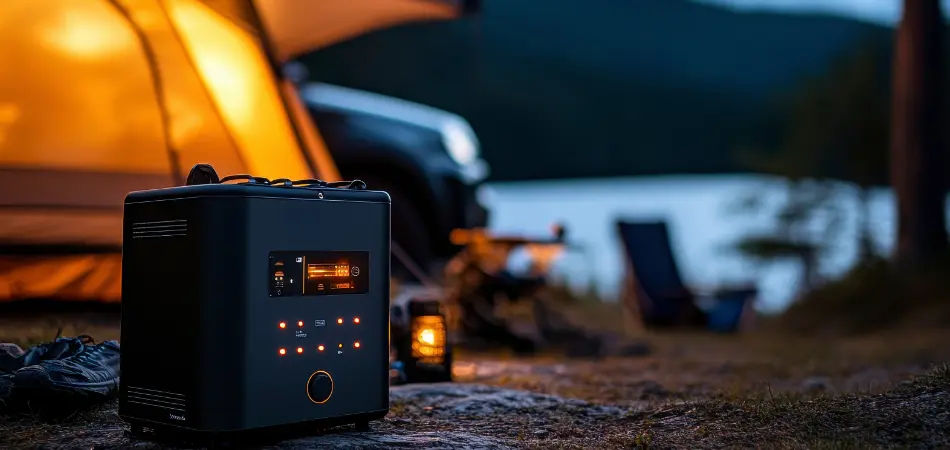An Overview of Portable Power Stations & How They Work

“Portable power” evokes mental images of noisy, stinky, gas-powered generators. Who wants that on a camping trip?
More and more, though, gas generators are giving way to portable power stations — fancy-pants battery packs. These marvels of modern technology provide power without the noise, fumes, weight, and bulk of traditional generators.
But what exactly are portable power stations, and how do they work? In this blog, we’ll take a look under the hood, so to speak.
What Is a Portable Power Station?
A portable power station is an easy-to-transport battery pack. You may already have something like this for your mobile phone — a small battery to recharge your phone in emergencies. A portable power station scales up the concept to electrify larger devices, like laptops and small appliances.
How Does a Portable Power Station Work?
Portable power stations store electrical energy in batteries. When you plug your device into the power station, the stored energy is converted from DC (direct current) to AC (alternating current), which most devices use. This lets you charge or run your devices as if plugged into a regular outlet.
But where does the energy come from? Most portable power stations are charged through an external power source, such as a wall outlet or solar panel. The battery can also be recharged while in use, but this may take longer and drain the battery faster.
Key Components of a Portable Power Station
1. Battery Pack
Typically, rechargeable batteries come in lithium-ion or lithium-polymer varieties, balancing weight and capacity. This enables you to charge smartphones, laptops, cameras, and even small appliances multiple times before requiring a recharge.
2. Inverter
The inverter converts the DC (direct current) stored in the battery to AC (alternating current) used by most household appliances. This conversion is crucial for devices like laptops and lamps, which need a steady AC current.
3. Input & Output Ports
Standard ports include USB, AC outlets, and DC carports, allowing simultaneous charging of multiple gadgets. Some advanced models support USB-C and wireless charging, accommodating the latest tech trends.
Top Applications for Portable Power Stations
1. Outdoor Adventures
Whether you’re camping, hiking, or picnicking, portable power stations give you access to power for lighting, cooking, and communication. Many models are rugged and weather-resistant, designed to withstand the elements and keep you connected even in remote locations.
2. Emergency Preparedness
Doomsday preppers understand the importance of having a reliable power source during unexpected events. Portable power stations provide backup power for essential devices like radios, medical equipment, and emergency lighting. Their ability to recharge through solar panels ensures you’re prepared even when the grid goes down.
3. Digital Nomads
Digital nomads need a consistent power supply to work from anywhere. Portable power stations let them set up workstations in remote locations, powering laptops, phones, and Wi-Fi hotspots. This flexibility allows for productivity while enjoying the freedom of a nomadic lifestyle.
4. Home Use & Convenience
Portable power stations can serve as a backup power source during short-term outages. They’re perfect for outdoor gatherings, powering speakers, projectors, or lighting. Their quiet and eco-friendly design keeps them out of the way, and their user-friendly interface makes them accessible to people of all technical abilities.
FAQs: About Portable Power Stations
Q: Are portable power stations safe?
Yes. Features like battery management systems and built-in surge protection ensure safe operation and prevent electrical hazards.
Q: How long do portable power stations last?
The lifespan of a portable power station depends on factors like usage, battery type, and maintenance. Most lithium-based batteries have a lifespan of 500 to 1,000 charge cycles, equivalent to several years of regular use.
Q: Can portable power stations run appliances like refrigerators?
Small appliances like mini-fridges can be powered by larger portable power stations with sufficient capacity (measured in watt-hours). However, running larger appliances may require multiple power stations.
Q: How do I choose the right portable power station?
Consider capacity, weight, number of output ports, and charging options. Assess your power requirements and match them with a power station that meets your needs.
Q: Can I take a portable power station on a plane?
Yes, but with restrictions. Most airlines allow portable power stations with lithium-ion batteries under 100Wh in carry-on luggage. For larger batteries, you may need special permission. Check with your airline ahead of your trip.
Q: How do I maintain my portable power station for longevity?
Store it in a cool, dry place and avoid extreme temperatures. To keep the battery healthy, regularly charge and discharge it, especially if stored for long periods.
Q: Are there environmentally friendly options for charging a portable power station?
Many portable power stations can be charged using solar panels, a sustainable and eco-friendly solution.
Q: What should I do if my portable power station stops working?
Check the manufacturer’s troubleshooting guide for common issues. If unresolved, contact customer support for assistance. DO NOT open the device, which may void the warranty and cause safety hazards.
More Articles

0 Comments